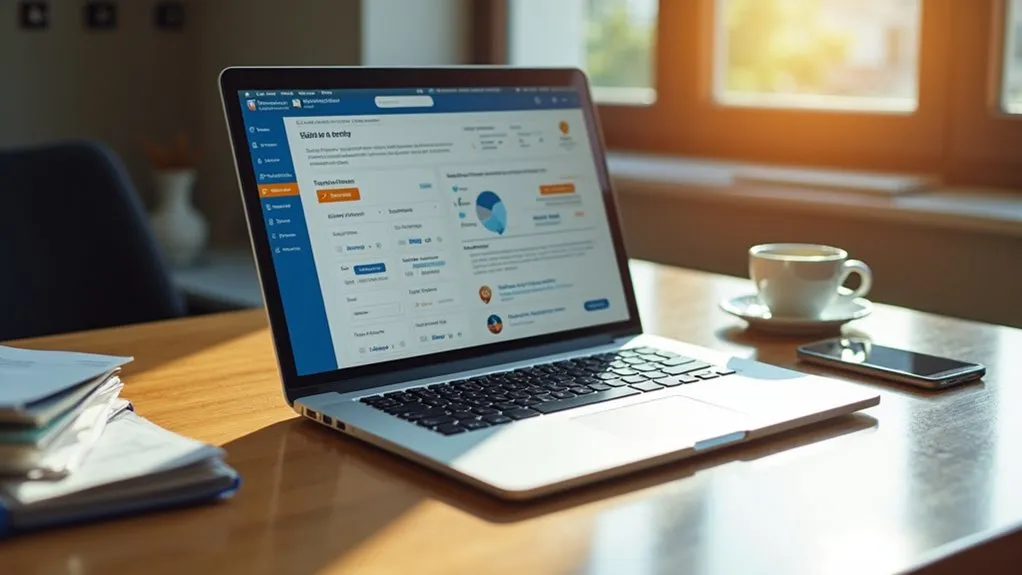To trace and track a package easily, one should first obtain the tracking number from email confirmations, shipping labels, or retailer order histories. Next, input this number on the carrier’s website, like USPS or UPS, for real-time updates, or use their mobile apps for notifications. Alternatively, universal platforms like 17Track aggregate data from multiple carriers for convenience. For delays, verify the number and contact the carrier. Explore further for additional insights and tips.
Key Takeaways
- Check your email confirmation or shipping label for the tracking number provided by the retailer.
- Enter the tracking number on the carrier’s website, like USPS or UPS, for real-time updates.
- Download carrier apps, such as USPS Mobile, to monitor packages with GPS and notifications.
- Use universal platforms like 17Track or AfterShip to track packages from multiple carriers easily.
- Contact the carrier or sender with your tracking number if delays or issues arise.
Getting Your Tracking Number
Countless packages traverse the globe daily, and obtaining a tracking number is the critical first step to monitor a shipment’s journey. This unique identifier, assigned by the shipper at dispatch, is often a mix of letters and numbers, varying by carrier—USPS may use 20-22 digits, while UPS typically starts with “1Z” across 18 characters.
Systematically, one can secure this number through multiple channels. Email retrieval is a primary method; shippers frequently include the tracking number in dispatch confirmation emails. If not received, contacting the retailer directly is advised. Alternatively, label inspection offers a reliable approach—numbers are printed on shipping labels near barcodes or on mailing receipts from post offices. For online purchases, checking order history on retailer websites or marketplaces like Amazon often reveals the number. Retaining receipts and labels until delivery confirmation ensures access to this essential data for tracking purposes. Additionally, tracking numbers enable real-time monitoring of your package’s location real-time monitoring from origin to destination.
Using Carrier Platforms for Updates
How can one stay informed about a package’s journey after obtaining the tracking number? Utilizing carrier platforms offers a systematic approach to tracking. Major carriers like USPS, UPS, FedEx, and DHL provide robust websites and portals where users can input the tracking number for real-time updates, detailed history, and estimated delivery times. These platforms often feature app integration, allowing seamless access through carrier-specific mobile apps like USPS Mobile or UPS My Choice for on-the-go monitoring with GPS-based updates.
Additionally, setting up notifications ensures timely alerts. Through notification setup on carrier systems like FedEx Delivery Manager or USPS Informed Delivery, users receive email or SMS updates on statuses such as shipped, in-transit, or delivered. This reduces anxiety and enhances security. Advanced features, including delivery customization and instructions, further refine the process, ensuring recipients remain well-informed about their package’s progress with precision and efficiency.
Exploring Universal Tracking Solutions
What options exist for tracking packages across multiple carriers without navigating numerous websites? Universal tracking solutions offer a streamlined approach by aggregating data from thousands of carriers worldwide, boasting impressive Global Reach. Platforms like 17Track and AfterShip provide a single interface—via website or app—where users input a tracking number for automatic carrier detection and real-time updates, eliminating repetitive site visits.
These tools enhance user experience with robust App Features, including delivery notifications, map views, and estimated delivery dates. Below is a snapshot of popular platforms and their offerings:
| Platform | Carrier Support | Key Feature |
|---|---|---|
| 17Track | 1500+ carriers | Multi-language support |
| AfterShip | 1000+ carriers | Branded tracking pages |
| Ship24 | 1200+ carriers | Real-time map tracking |
| Parcel Monitor | 2400+ carriers | Automated notifications |
| TrackingMore | 1100+ carriers | API integration |
Such systematic solutions ensure transparency and convenience, catering efficiently to both consumers and businesses across global shipping networks.
Managing Delays and Tracking Problems

Frustration often accompanies package delays and tracking issues, disrupting the seamless delivery experience many expect. Common causes include logistical hiccups like incorrect labeling, external factors such as Weather Effects from storms or floods, and documentation errors tied to Customs Procedures for international shipments. Volume surges during holidays or labor shortages further complicate timely delivery.
When tracking information stalls, individuals should first verify the tracking number for accuracy. Checking the estimated delivery window can provide context on whether a delay is minor. If unresolved, contacting the carrier with the tracking number offers direct updates, while reaching out to the sender may yield additional insights. Patience is key initially, as minor delays often resolve within days. For persistent issues, especially those caused by Weather Effects or Customs Procedures, proactive communication from carriers or retailers helps manage expectations. Allowing buffer time and staying informed ensures a systematic approach to resolving problems efficiently.

 Tiếng Việt
Tiếng Việt 日本語
日本語 中文 (中国)
中文 (中国) 한국어
한국어
